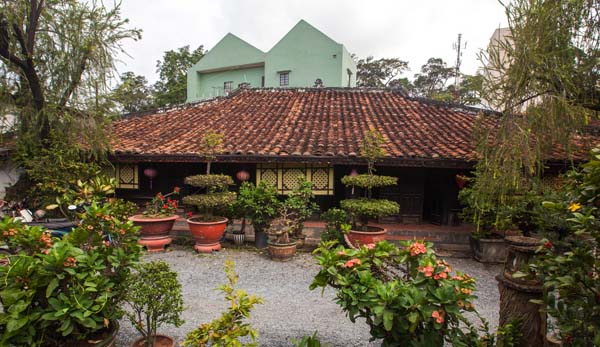(No.4, Vol.8,Aug-Sep Vietnam Heritage Magazine)




Architecture and culture experts say that the ancient house of Tran Cong Vang, with its Hue style interlocked beams, architecture, and numerous meticulously carved decor patterns and antiques is special among the few similar ancient houses still intact in the Southeastern Delta.
The house structure and the artifacts inside show quite vividly the lifestyle and cultural values of the wealthy of late 19th and early 20th centuries.
The house of Tran Cong Vang at 21 Ngo Tung Chau Street, Phu Cuong Ward, Thu Dau Mot City of Binh Duong Province has been recognized a National Relic of Art and Architecture since 1993 by the Ministry of Culture, Sports and Tourism.
A wooden house without a single iron nail
Feng-shui masters say that the house is well-located: with a hill behind it and a river at the front, it is very convenient for transporting wood logs down from the forests.
Old documents show that the first owner of the house was Mr Tran Cong Doan. But the house bears the name of Mr Tran Cong Vang, a 4th generation descendant of Mr Doan. Currently Mr Vang’s children and grandchildren take care of the house and guide tourists around the site.
The records department of Binh Duong Province’s Relic Sites Management says that the house of Tran Cong Vang was built in late 19th century. A small courtyard separates the main and subsidiary structures. Most of the buildings were made of precious timber such as sao, trac, and mun. Most remarkably, parts are joined by tenons and mortises without a single iron nail.
Being a lumberman and owning a timber processing station was a huge advantage for the first owner and builder of the house. A large number of carpenters and artisans of the highest skill at the time took part in completing the house.
The house of Tran Cong Vang has a total area of about 450m2, built on a 1,333m2 property. The main house, 323m2 in area, includes the owner family’s living quarters, where they receive distinguished guests and host big family and community events. The auxiliary structures, simpler and more modest, 119m2 in area, include a kitchen, a dining room and a room where common people were received.
The front courtyard currently has a number of bonsai and flowerpots that are even more eye-pleasing.
The main house – a work of art
The house is roofed with ancient double tiles. The roof is supported by girders, beams and purlins robustly but gracefully joined, with all tenons carved beautifully and meticulously as dragon heads. The whole structure is supported by 48 cylindrical pillars, carefully polished and beautifully adorned.
The side and back walls are built with bricks and lime. The front wall consists of a number of thick and strong sliding removable wooden panels. The space inside is divided by wooden panels into compartments which serve as bedrooms, living rooms, and altar rooms. Each piece of wood, including sliding and turning doors and windows, and dividing panels is a unique work of art, and the whole structure is a feat of structural engineering and architectural design.
The other elements of interior design and decoration such as the altar and its utensils, tables and chairs, calligraphic decorations and paintings are valuable works of carving art in their own right. Pieces of furniture are arranged in the style of an old Vietnamese family, cozy and convenient.
All the carvings and relief patterns seen on the antique pieces of furniture in the house follow the motif of flora and fauna and geometrical figures, expressing an aspiration for a happy harmonious life. The same aspiration is also expressed in parallel sentences and calligraphic works carved on precious wood panels.
On the sides of the main gate, a pair of parallel sentences greets visitors and bids them to feel at home. On the second row of pillars, one sees another pair advising everyone to follow ancient rules of good living. At the ancestral altar, a calligraphic scroll instructs children to have filial devotion and piety towards the family, and a serene and pure heart for the deities.


